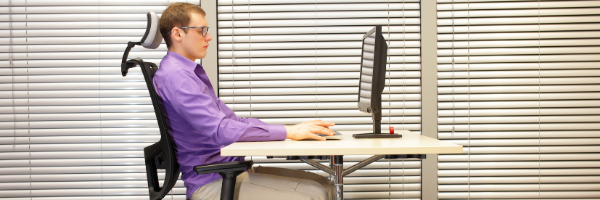
Ergonomics. A word you hear a lot about when it comes to your desk at work. Now that we are working mostly from home, and it seems likely that this is what we will be doing more of moving forward, we need to make sure our work stations at home are set up to keep our bodies healthy.
When working from home, there are several factors you want to consider:
- The environment of where you choose to set up your work station
- The setup of your work station
- Remembering to pay attention to how your body is feeling
The environment you choose to set up your home work station is important for many reasons. There are many distractions in your own home and this can add stress to your day. Choosing a room or space that is quiet and free of things like a television keeps you from getting sidetracked. Being away from the common areas, like the living room or kitchen, is helpful to avoid the distractions of others living in your home (a.k.a. your amazing family).
Being in a room with windows is great for keeping your energy levels up and keeping your mood more elevated to help encourage mental clarity.
A clutter-free space is also key to minimizing stress and anxiety in an already challenging new way to work. Another great tip from Health Canada is to keep the room at a comfortable temperature with good ventilation.
Of course, the layout and set-up of your work station, including your chair, desk, and computer, is very important, and most companies make sure this is implemented in the office. This helps avoid poor posture, body mechanics and injuries. Being in a seated position for long periods of time (over the course of the day and in the long-term) can also affect your health in general. But before we get into that, let’s talk about your work station set up at home.
Things to consider when setting up a healthy and productive home work station:
- A good chair: you need one that supports the curve of your spine, is set at the right height for your legs and arms and is comfortable to sit in.
- Desk: your desk should have leg clearance and be at the right height to comfortably use your keyboard, view your monitor, etc. If you need to lift the chair and your feet aren’t sitting flat on the floor, use a foot stool to raise your feet.
- Monitor: place it directly in front of you, at an arm’s length away. The top of the screen should be at or slightly below eye level.
- Keyboard and mouse: try to keep your wrists straight and use keyboard shortcuts as much as possible to avoid excessive mouse use. Also, alternating between arms throughout the day in using the mouse prevents overuse on one arm.
Keep things you use often, such as your cell phone, pen and paper, stapler or folders, etc., near you so you avoid overreaching. You are better off to get up and get what you need if it isn’t within arm’s reach.
Here is a handy work station checklist from Health Canada.
As I mentioned earlier, sitting every day for long periods of time can be hard on your body and your health. Being aware of the negative effects may just motivate you to set up a proper work station.
Here are some health issues that can arise if you sit daily for prolonged periods of time:
- Disruption of the function of internal organs, which can cause digestive issues and breathing problems. Sitting, especially with poor posture, reduces blood flow and compresses internal organs, specifically the stomach and bowels, which leads to digestive issues. A rounded back, or upper cross syndrome, is common from excessive sitting. The tightness this causes in the chest doesn’t allow the lungs to expand properly due to the rib cage being tucked down. This causes rapid short breaths.
- Negatively affects blood circulation, which can cause minor issues like low energy and lack of nutrient absorption, as well as more harmful issues, including DVT (deep vein thrombosis), varicose veins, heart disease, and diabetes.
- Muscle tightness, which can lead to poor body mechanics and poor posture. These can cause injury and/or pain over time.
To avoid these issues, it is suggested that you get up often and move around in some way. It can be as simple as getting up to grab a glass of water to stay hydrated or using the washroom. When taking phone calls, get up and pace.
Our bodies work on different rhythms, one type of which are called ultradian rhythms.
This is basically the cycle of work/rest ratios in the body. The human body tends to move through 90- to 120-minute cycles. During the day, these are experienced as different levels of energy or alertness. After 90 minutes, the body goes into what is called an ultradian healing response (a rest period). You may notice you get tired or antsy after sitting for 90 minutes. This is your body naturally sending you a message, telling you to stop and take a 5- to 20-minute break. Your level of alertness will determine how long you should rest. Aim for restful activity over grabbing sugary foods or caffeine.
Getting up every couple of hours will help with blood circulation and help you avoid getting overly tight muscles. Stretching before you start your work day, at midday, and after work is a great way to help avoid poor body mechanics and to maintain a healthy posture.
Muscles that typically tighten up from sitting down for too long are the chest, lower back, hip flexors/adductors, shoulders and glutes. The stretches described below target these muscles and only take five minutes to do. This means if you do these stretches three times per day, it is only 15 minutes per day — quick and necessary to help keep your body moving better and keep you pain free.
Here are some stretches that target muscles that can get tight from prolonged sitting:
Neck: Sit tall and with one arm, grab the side of your chair. Take the other hand and place your fingers just above your ear and pin them down. Take a deep breath and as you exhale, tilt your head to the same side. Only go as far over as comfortable. Keep taking deep breaths in and out. On each exhale, relax into the stretch. Now in this same position, tilt your chin towards the shoulder of the arm that is on your head. Keep fingers pinned in the same spot. Repeat the same steps on the other side.
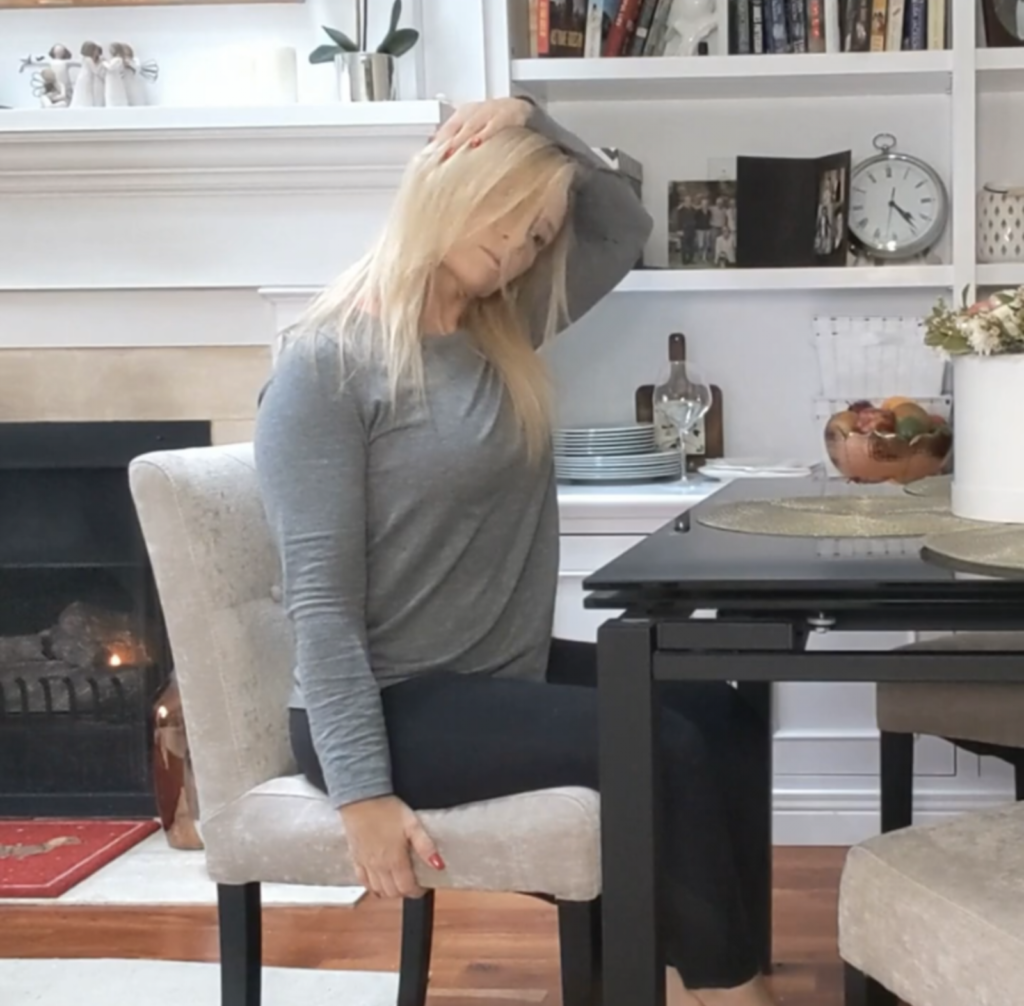
Hips: Sit tall and place the side of one foot on the opposite leg. Push the knee slightly down but only until you feel a slight stretch. If you can, lean slightly forward to get a bit deeper. If this is too much, stay upright. Take deep breaths in and out. On each exhale, relax into the stretch. Repeat the same steps on the other leg.
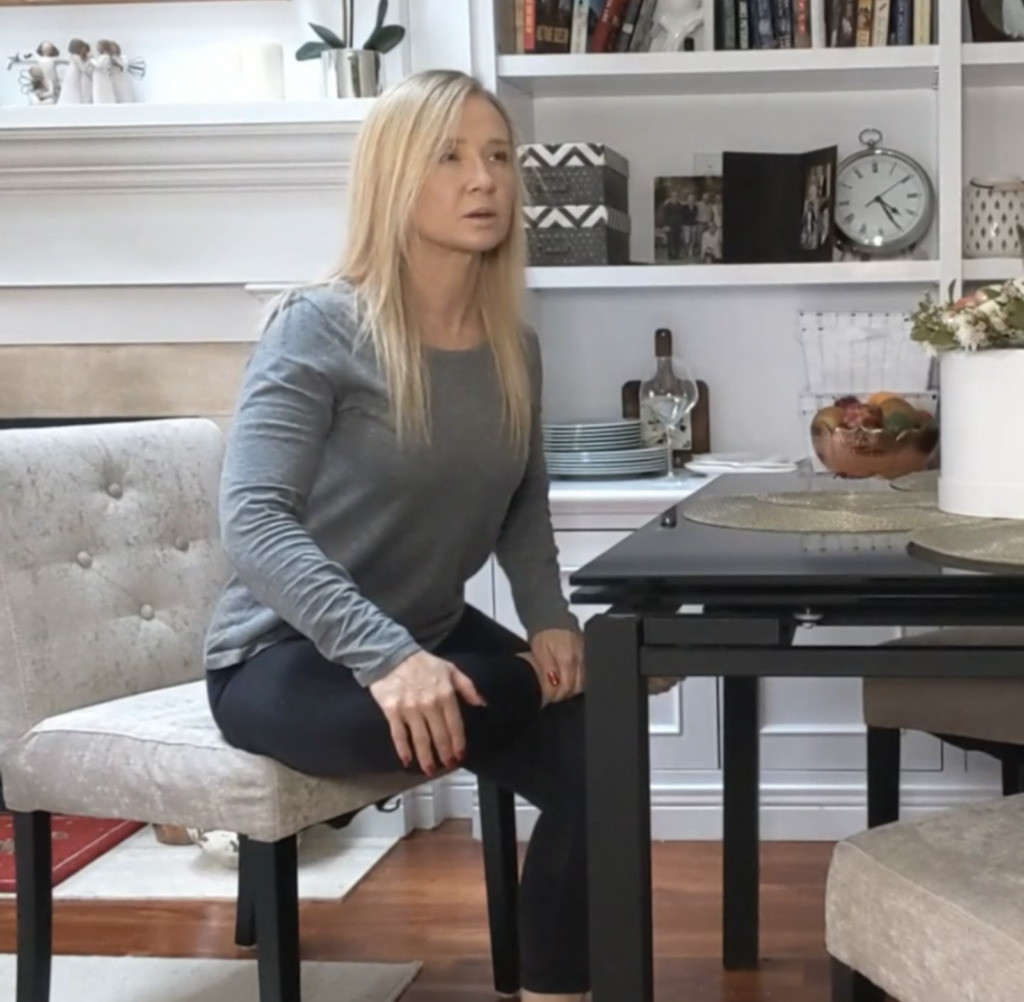
Chest: Sit centred and then reach your arm back, twisting to reach over to the other side of the chair (move hips with you if you need to). Rest your palm on the outer side of the chair with your thumb up. Twist your chest back towards the front, but only as far as you comfortably can. Take deep breaths in and out. On each exhale, relax into the stretch. Repeat the same steps on the other side.
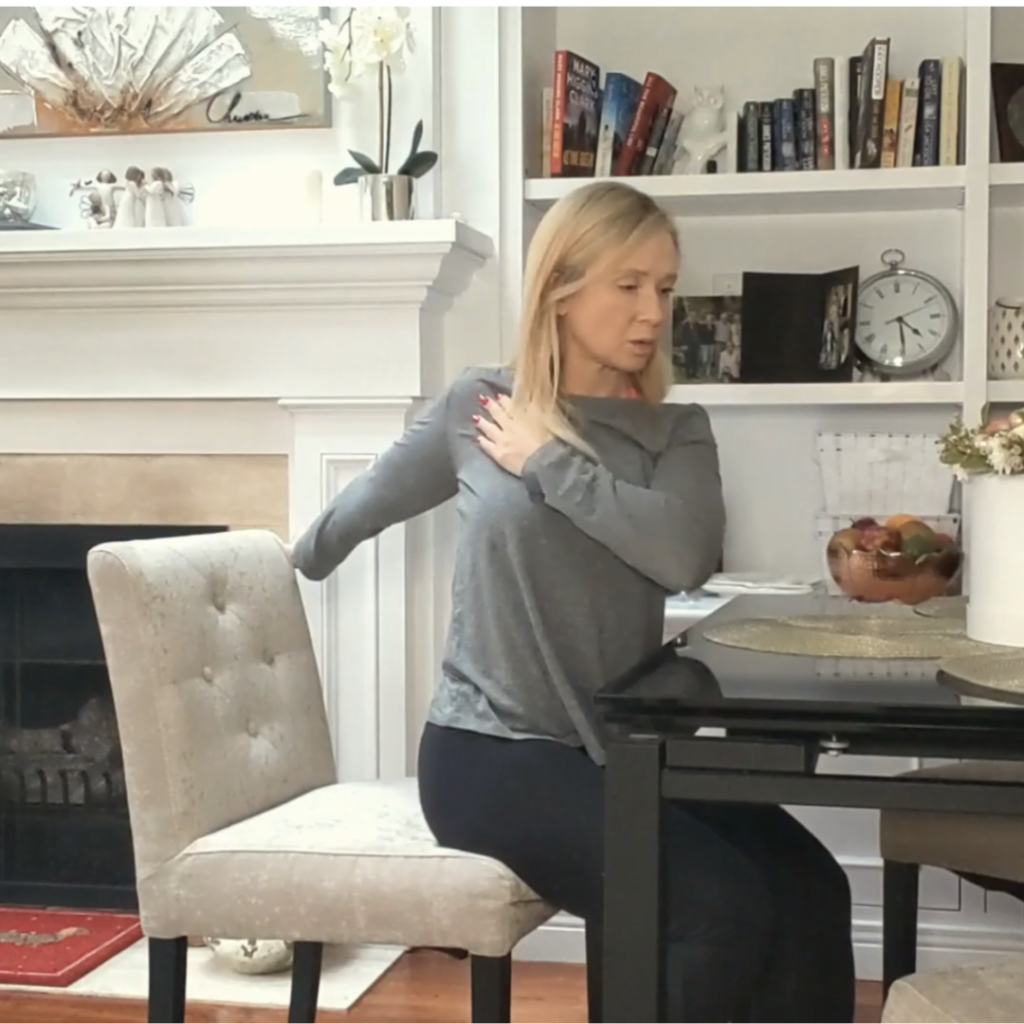
Shoulders and back: Sitting tall, lift one arm up and place your other hand just above the opposite arm’s elbow. Keep your neck and shoulders relaxed and pull the arm in towards your chest. Keep the arm at 90° to make the movement easier. Take deep breaths in and out. On each exhale, relax into the stretch. Repeat the same steps on the other arm.
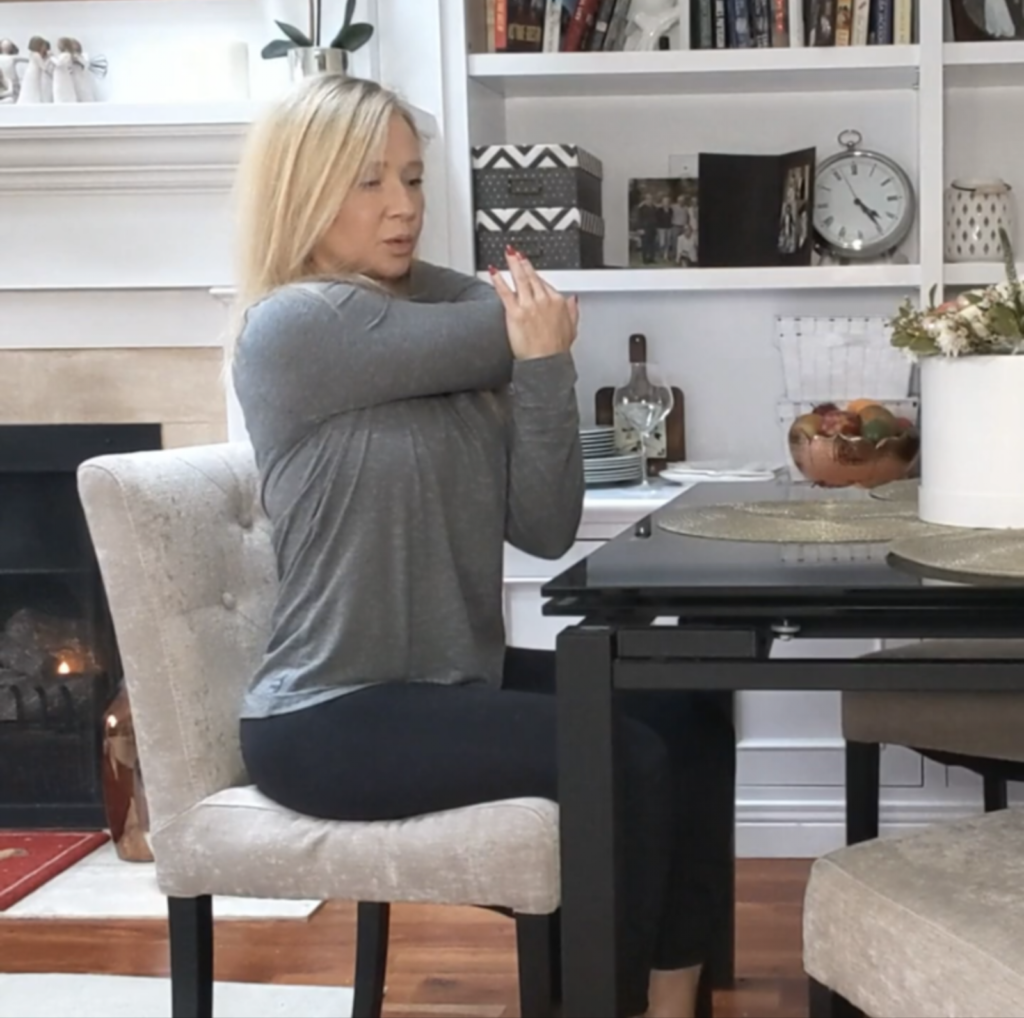
Hamstrings, glutes, lower back: Stand up, and, keeping legs as straight as you can, reach towards your feet (you don’t need to touch your feet). As you come back up, squeeze your glutes and reach towards the ceiling. Inhale as you go down and exhale on the reach. Keep repeating this pattern. You will notice that with each stretch, your hands will get lower to the ground.
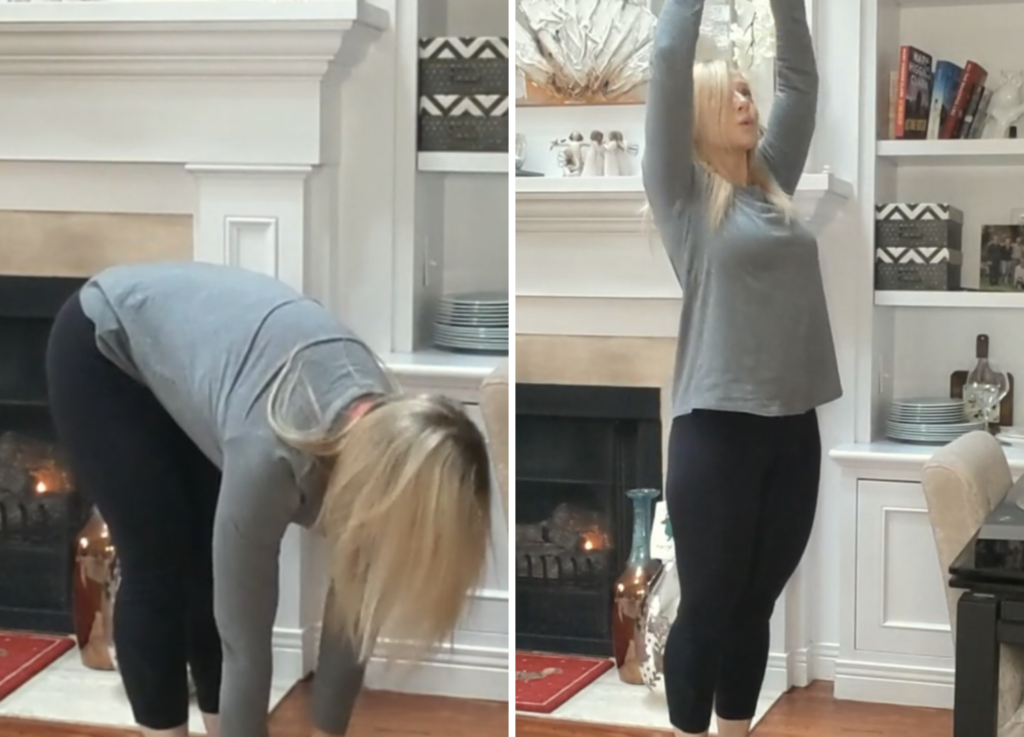
Adductors (inner thigh): Stand sideways in front of your chair. Lift one leg up onto the chair, resting on your heel. Point toes up towards the ceiling as much as you can. Keeping your hips square, press your glutes (hips) back with a neutral spine, leaning forward slightly. Hold there for a couple of seconds and return to standing. Repeat with deep breathing until you feel some relief.
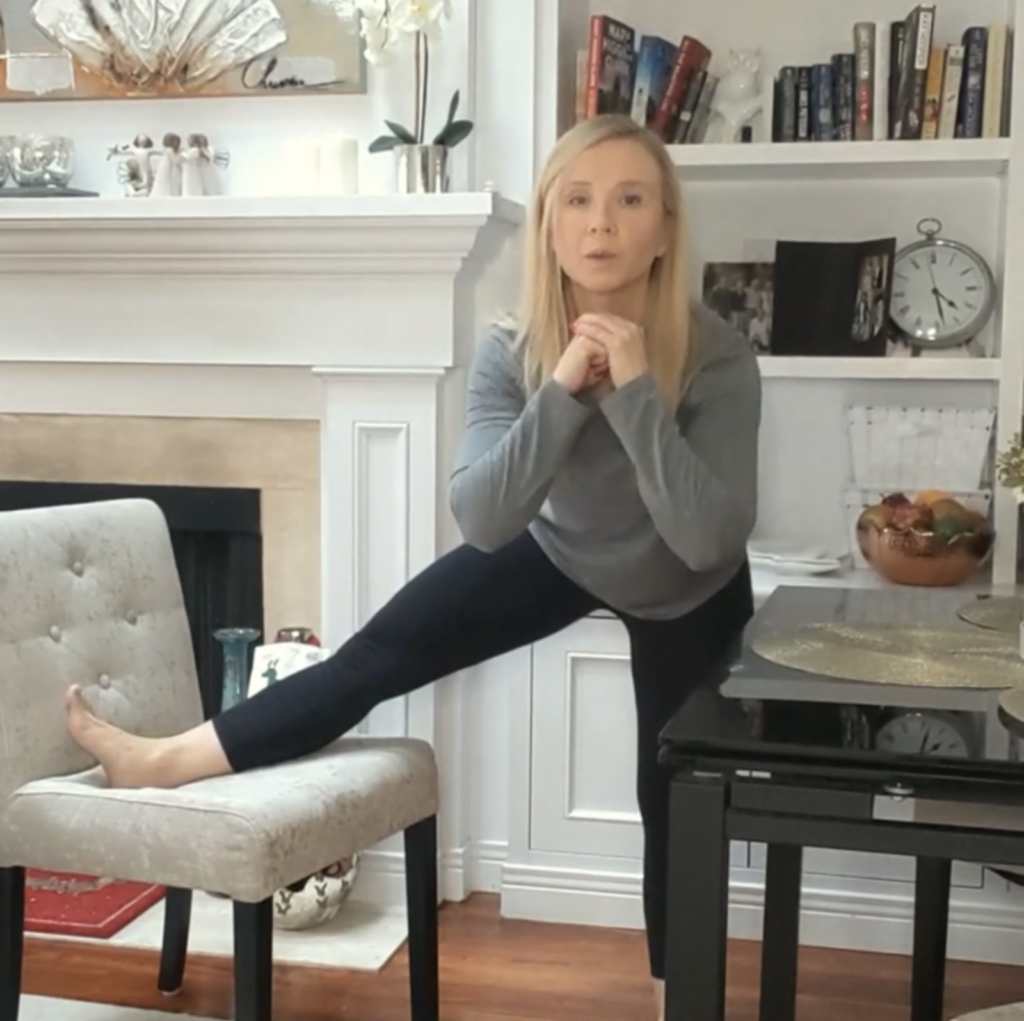
It is easy to get consumed and forget what your body needs. Make it a rule of thumb to get up every couple of hours and get your blood pumping a bit. Pro tip: set a timer to remind you to get up and get moving!
Sources:
Benatti, F.B., and Ried-Larsen, M. 2015. The Effects of Breaking Up Prolonged Sitting Time: A Review of Experimental Studies. Medicine & Science in Sports & Exercise, 47(10): 2053–2061. Url: https://pdfs.semanticscholar.org/ead1/47fcf041cb954f807e04e2ae9e5377a3a5b1.pdf (accessed Jan 25. 2021).
Environment and Climate Change Canada. n.d. Home Office Ergonomics: Your Prolonged Remote Work from Home Guide. Url: https://www.canada.ca/content/dam/eccc/documents/pdf/corporate-info/covid-19/2020-04-08_Ergo_TeleworkTips_E.pdf (accessed Jan. 25, 2021).
Health Canada. n.d. Adjusting and Adapting Your Computer Workstation. Url: https://www.hrce.ca/sites/default/files/hrsb/Downloads/pdf/HR/OH&S/Ergonomics%20Checklist.pdf (accessed Jan. 25, 2021).



